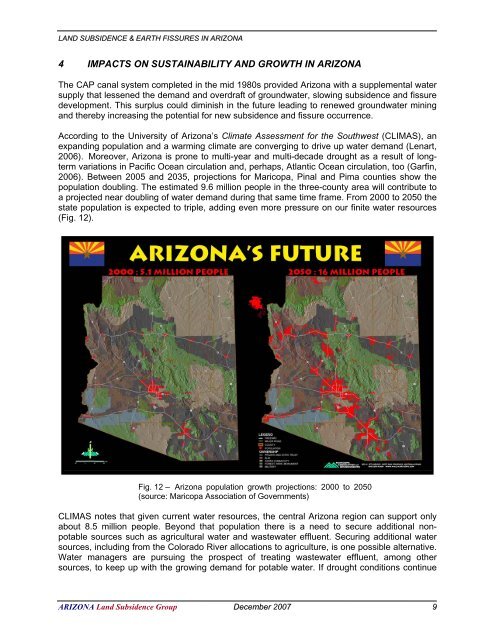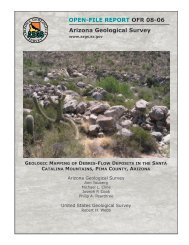land subsidence and earth fissures in arizona - The Arizona ...
land subsidence and earth fissures in arizona - The Arizona ...
land subsidence and earth fissures in arizona - The Arizona ...
You also want an ePaper? Increase the reach of your titles
YUMPU automatically turns print PDFs into web optimized ePapers that Google loves.
LAND SUBSIDENCE & EARTH FISSURES IN ARIZONA<br />
4 IMPACTS ON SUSTAINABILITY AND GROWTH IN ARIZONA<br />
<strong>The</strong> CAP canal system completed <strong>in</strong> the mid 1980s provided <strong>Arizona</strong> with a supplemental water<br />
supply that lessened the dem<strong>and</strong> <strong>and</strong> overdraft of groundwater, slow<strong>in</strong>g <strong>subsidence</strong> <strong>and</strong> fissure<br />
development. This surplus could dim<strong>in</strong>ish <strong>in</strong> the future lead<strong>in</strong>g to renewed groundwater m<strong>in</strong><strong>in</strong>g<br />
<strong>and</strong> thereby <strong>in</strong>creas<strong>in</strong>g the potential for new <strong>subsidence</strong> <strong>and</strong> fissure occurrence.<br />
Accord<strong>in</strong>g to the University of <strong>Arizona</strong>’s Climate Assessment for the Southwest (CLIMAS), an<br />
exp<strong>and</strong><strong>in</strong>g population <strong>and</strong> a warm<strong>in</strong>g climate are converg<strong>in</strong>g to drive up water dem<strong>and</strong> (Lenart,<br />
2006). Moreover, <strong>Arizona</strong> is prone to multi-year <strong>and</strong> multi-decade drought as a result of longterm<br />
variations <strong>in</strong> Pacific Ocean circulation <strong>and</strong>, perhaps, Atlantic Ocean circulation, too (Garf<strong>in</strong>,<br />
2006). Between 2005 <strong>and</strong> 2035, projections for Maricopa, P<strong>in</strong>al <strong>and</strong> Pima counties show the<br />
population doubl<strong>in</strong>g. <strong>The</strong> estimated 9.6 million people <strong>in</strong> the three-county area will contribute to<br />
a projected near doubl<strong>in</strong>g of water dem<strong>and</strong> dur<strong>in</strong>g that same time frame. From 2000 to 2050 the<br />
state population is expected to triple, add<strong>in</strong>g even more pressure on our f<strong>in</strong>ite water resources<br />
(Fig. 12).<br />
Fig. 12 – <strong>Arizona</strong> population growth projections: 2000 to 2050<br />
(source: Maricopa Association of Governments)<br />
CLIMAS notes that given current water resources, the central <strong>Arizona</strong> region can support only<br />
about 8.5 million people. Beyond that population there is a need to secure additional nonpotable<br />
sources such as agricultural water <strong>and</strong> wastewater effluent. Secur<strong>in</strong>g additional water<br />
sources, <strong>in</strong>clud<strong>in</strong>g from the Colorado River allocations to agriculture, is one possible alternative.<br />
Water managers are pursu<strong>in</strong>g the prospect of treat<strong>in</strong>g wastewater effluent, among other<br />
sources, to keep up with the grow<strong>in</strong>g dem<strong>and</strong> for potable water. If drought conditions cont<strong>in</strong>ue<br />
ARIZONA L<strong>and</strong> Subsidence Group December 2007 9

















